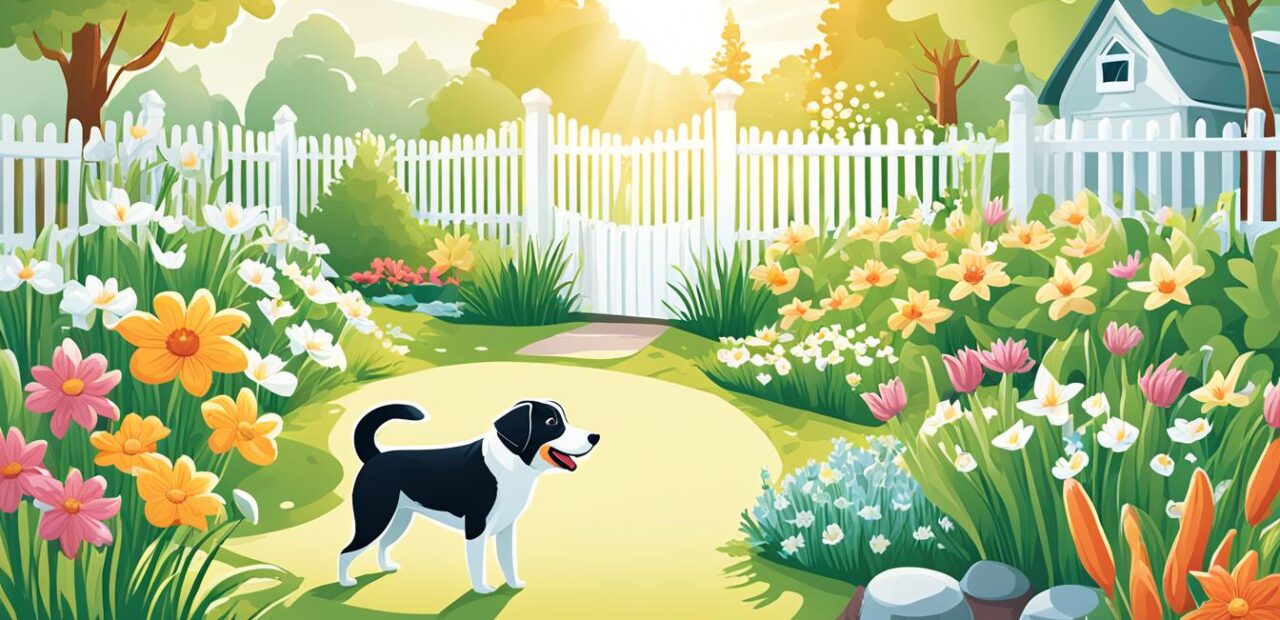Pet-Proof Plants: Landscaping for Dog Safety
Did you know that many common plants can be toxic to pets, putting their health and safety at risk? Some plants, such as daylilies and sago palms, can even be deadly to dogs and cats. This surprising fact highlights the importance of landscaping with pet-safe plants and creating a toxin-free garden in your backyard.
Key Takeaways:
- Many common plants can be toxic to pets.
- Landscaping with pet-safe plants is crucial for a dog-friendly backyard.
- Creating a toxin-free garden ensures the health and safety of your pets.
Understanding the Dangers of Certain Plants
While many plants are safe for pets, there are certain plants and flowers that can be dangerous and toxic to dogs. It’s important for pet owners to be aware of these plants to ensure the safety and well-being of their furry friends. Here is a comprehensive list of poisonous plants for dogs, toxic flowers, and harmful garden vegetation:
- Aloe Vera
- Carnations/Sweet William
- Chrysanthemums
- Dahlias
- Daisies
- Elephant Ear
- Hosta
- Iris
- Lily of the Valley
- Lobelia
- Milkweed
- Monkshood
- Peonies
- Yarrow
- Asparagus Fern
- Begonia
- Coleus
- Geranium
- Kalanchoe
- Moss Rose
- Nicotania
- Apple and Cherry Trees
- Azalea/Rhododendron
- Boxwood
- Citrus Trees
- Cycads/Sago Palm
- Dog Hobble
- Gardenia
- Holly
- Hydrangea
- Lantana
- Oak Trees
- Oleander
- Pieris
- Rose of Sharon
- Yew
- Amaryllis
- Caladium
- Calla Lily
- Crocus
- Daffodil and Jonquil
- Gladiola
- Hyacinth
- Lily
- Tulip
It is crucial to avoid planting these toxic plants in your garden or backyard where your pets have access. Take note of these harmful plants and ensure the safety of your furry companions.
Preventing Accidental Poisoning
Now that you are aware of the poisonous plants for dogs, take proactive steps to prevent accidental poisoning. Here are a few tips:
- Research the safety of plants before adding them to your garden.
- Monitor your dog’s outdoor activities to prevent them from consuming harmful vegetation.
- Train your dog to avoid chewing or ingesting plants.
- Keep your dog on a leash or supervise them when exploring unfamiliar areas.
- In case of ingestion, consult a veterinarian immediately. Time plays a crucial role in treating plant poisoning.
By being knowledgeable and taking precautions, you can create a safe environment for your beloved pets and enjoy your garden without worrying about the harmful effects of certain plants.
Creating a Dog-Friendly Backyard Landscape
When it comes to designing a dog-friendly backyard, there are plenty of ideas that can help you create a safe and enjoyable environment for your furry friends. By incorporating these dog-friendly backyard ideas, you can ensure that your pets have a space where they can run, play, and relax.
1. Designated Dog Run
Creating a designated dog run is an excellent way to give your dog a safe space to roam and exercise. Whether it’s a fenced-in area or a specific corner of your backyard, a dog run allows your pet to get their daily exercise without the risk of escaping.

2. Canine Agility Course
For energetic and active dogs, setting up a canine agility course can provide mental and physical stimulation. This course can include obstacles like tunnels, hurdles, and weave poles, challenging your dog’s agility and coordination.
3. Shallow Pools for Dogs
Dog-friendly shallow pools can be a great addition to your backyard, especially during hot summer days. Dogs love water, and having a designated pool where they can cool off and have fun is a paw-some idea.
4. Sandbox for Dogs
If your dog enjoys digging, setting up a sandbox can be a fun play area. Fill it with dog-safe sand and provide digging toys to keep them entertained. It’s important to teach them that the sandbox is the only appropriate place to dig.
5. Edible Gardens for Pets
Creating an edible garden specifically for your pets can offer them a unique sensory experience. Plant dog-friendly herbs and vegetables like mint, parsley, carrots, and lettuce. Not only will your pets enjoy the fresh flavors, but it can also save you money on pet-friendly treats.
By incorporating these dog-friendly backyard ideas, you’ll be able to create a space that both you and your pets can enjoy. Remember to prioritize safety, provide ample shade and water, and keep plants and materials non-toxic for your furry friends.
Designing a Dog-Friendly Landscape
When creating a landscape that is safe and enjoyable for your furry friends, it’s essential to consider the use of dog-friendly hedges instead of traditional fences. These hedges not only provide privacy and containment but also offer a natural and aesthetically pleasing solution. Unlike typical fences, dog-friendly hedges create a green and vibrant atmosphere in your backyard, enriching the overall environment for both your pets and family.
Dense hedges can serve as green fences, acting as a barrier and creating a safe space for your dogs to roam freely while ensuring their security. These non-toxic hedge options offer a beautiful and functional alternative, combining both form and function in your landscape design.
Some popular dog-friendly hedge options to consider include:
- Camellia
- Osmanthus
- Shrub Rose
- Fringe Flower
- Arborvitae
- Cypress
- Pyracantha
These plants can be strategically spaced and allowed to grow together, creating a dense hedge that not only provides a visual barrier but also ensures the safety of your dogs within your property.
When designing your dog-friendly landscape, it’s important to consider the specific needs of your pets. Providing ample shade, a soft resting area, protection from the elements, and a source of clean water are essential elements to consider for your dog’s comfort and well-being.
By incorporating dog-friendly hedges and tailoring your landscape design to meet your dog’s needs, you can create a beautiful and safe environment where both you and your pets can enjoy the outdoors together.
Conclusion
Creating a safe backyard for dogs is essential to ensure their well-being and happiness. By following these pet-friendly landscaping tips, you can design a beautiful and secure outdoor space for your furry friends.
Start by incorporating pet-safe plants into your garden. Choose from a variety of non-toxic options such as African violets, bamboo palm, and lilac bushes. Consult with nurseries or online resources like the ASPCA for a comprehensive list of pet-friendly plants.
In addition to selecting safe plants, design appropriate play areas for your dogs. Consider creating a designated dog run for them to exercise, adding an agility course for mental stimulation, or setting up shallow pools for them to cool off. A sandbox can also cater to their digging instincts.
When designing your landscape, opt for dog-friendly hedges instead of traditional fences. Plant species like camellia, osmanthus, and cypress can form dense hedges that provide privacy and containment for your dogs. Don’t forget to consider their specific needs, such as shade, resting areas, and a source of clean water.
Remember to research and consult with professionals to ensure that your plants and landscaping choices are safe for your pets. With careful planning and consideration, you can create a toxin-free and playful backyard that will delight your beloved dogs.
















